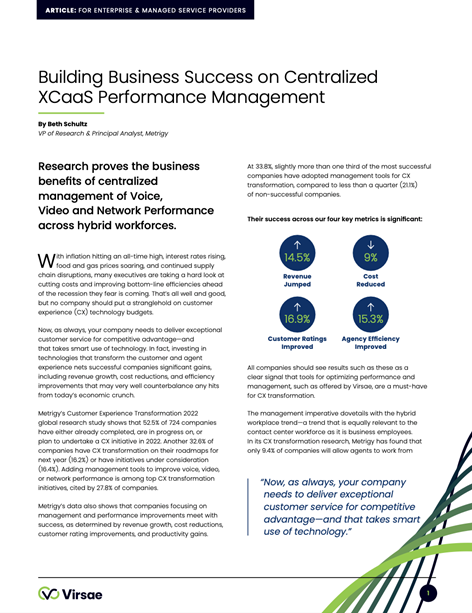Building Business Success on Centralized XCaaS Performance Management
Download the shareable PDF here
Research proves the business benefits of centralized management of Voice, Video and Network Performance across hybrid workforces.
With inflation hitting an all-time high, interest rates rising, food and gas prices soaring, and continued supply chain disruptions, many executives are taking a hard look at cutting costs and improving bottom-line efficiencies ahead of the recession they fear is coming. That’s all well and good, but no company should put a stranglehold on customer experience (CX) technology budgets.
Now, as always, your company needs to deliver exceptional customer service for competitive advantage—and that requires smart use of technology. In fact, successfully investing in technologies that transform the customer and agent experience nets significant gains, including revenue growth, cost reductions, and efficiency improvements that may very well counterbalance any hits from today’s economic crunch.
Metrigy’s Customer Experience Transformation 2022 global research study shows that:
- 52.5% of 724 participating companies have either already completed, are in progress on, or plan to undertake a CX improvement initiative in 2022.
- Another 32.6% of companies have CX transformation on their roadmaps for next year or have initiatives under consideration.
- Adding management tools to improve voice, video, or network performance is among top CX transformation initiatives, cited by 27.8% of participants.
Metrigy’s data also shows that companies focusing on management and performance improvements meet with success, as determined by revenue growth, cost reductions, customer rating improvements, and productivity gains. At 33.8%, slightly more than one third of the most successful companies have adopted management tools for CX transformation, compared to less than a quarter (21.1%) of non-successful companies.
The management imperative dovetails with the hybrid workplace trend—a trend that is equally relevant to the contact center workforce as it is business employees. In its CX transformation research, Metrigy has found that only 9.4% of companies will allow agents to work from home indefinitely while 17.2% of companies intend to have all agents work from the office. A hybrid workplace, in one form or another, is the preferred future for 49.6%.
Working back-and-forth between home and office brings a raft of new challenges, yet the priority to optimize CX doesn’t change. If customers can’t get what they need, quickly and perhaps better from your company than a competitor, they’re not going to be satisfied. And dissatisfied customers aren’t going to spend money on your products or services, and revenue will suffer. Poor voice and video experiences mean frustrated, and potentially lost customers.
To prevent poor-quality voice or video calls from marring a customer’s experience, home agents must have high-performance network connections. Yet, performance of home Wi-Fi and Internet connectivity registers among the biggest workplace challenges for companies participating in Metrigy’s digital workplace research. Clearly, agents who need to spend time troubleshooting their home setups rather than serving customers are neither efficient nor productive.
Assuring that a far-flung agent workforce doesn’t negatively impact business success requires that contact center managers be able to measure audio, visual, and network performance centrally, as well as facilitate onboarding by automating provisioning. Many companies already recognize the value of centralized management: In the Metrigy CX study, 54.2% of all companies and 61.1% of the most successful companies identified centralized contact center management as vitally important.
Changing workplace dynamics can lead to changes in agent performance, as well. Some might encounter too many distractions working from home; others might struggle to develop necessary skills without in-person supervisor guidance; and some may get fatigued from either shuffling between home and office or never leaving home, or grappling with interactions across an omnichannel customer service organization. Whatever the case may be, the bottom line could take the hit. That’s why for 32.9% of companies, adding analytics to improve agent performance is yet another top CX initiative.
Being able to analyze agent performance and deliver actionable insight can help companies identify underperforming agents. Analytics can also help spot agents who are getting fatigued so that they can intervene before burnout leads to turnover—and the operational costs associated with continuous hiring and onboarding kill a budget. Additionally, they can use analytics tools to assess licensing, potentially shaving costs by shedding unused agent licenses.
Plain and simple, companies that spend more on CX technologies are more successful than others, no matter how large or small they are. It’s no surprise that 68.5% of Metrigy’s CX research success group plans to increase overall CX spending in 2023, vs. 38.1% of the non-success group.
The guidance is clear: Economic doldrums or not, investing in CX technologies, particularly those that will keep performance and agent workforce issues at bay, is a win.

